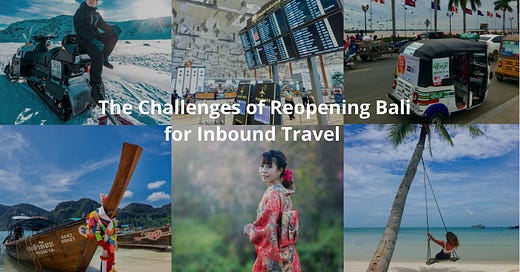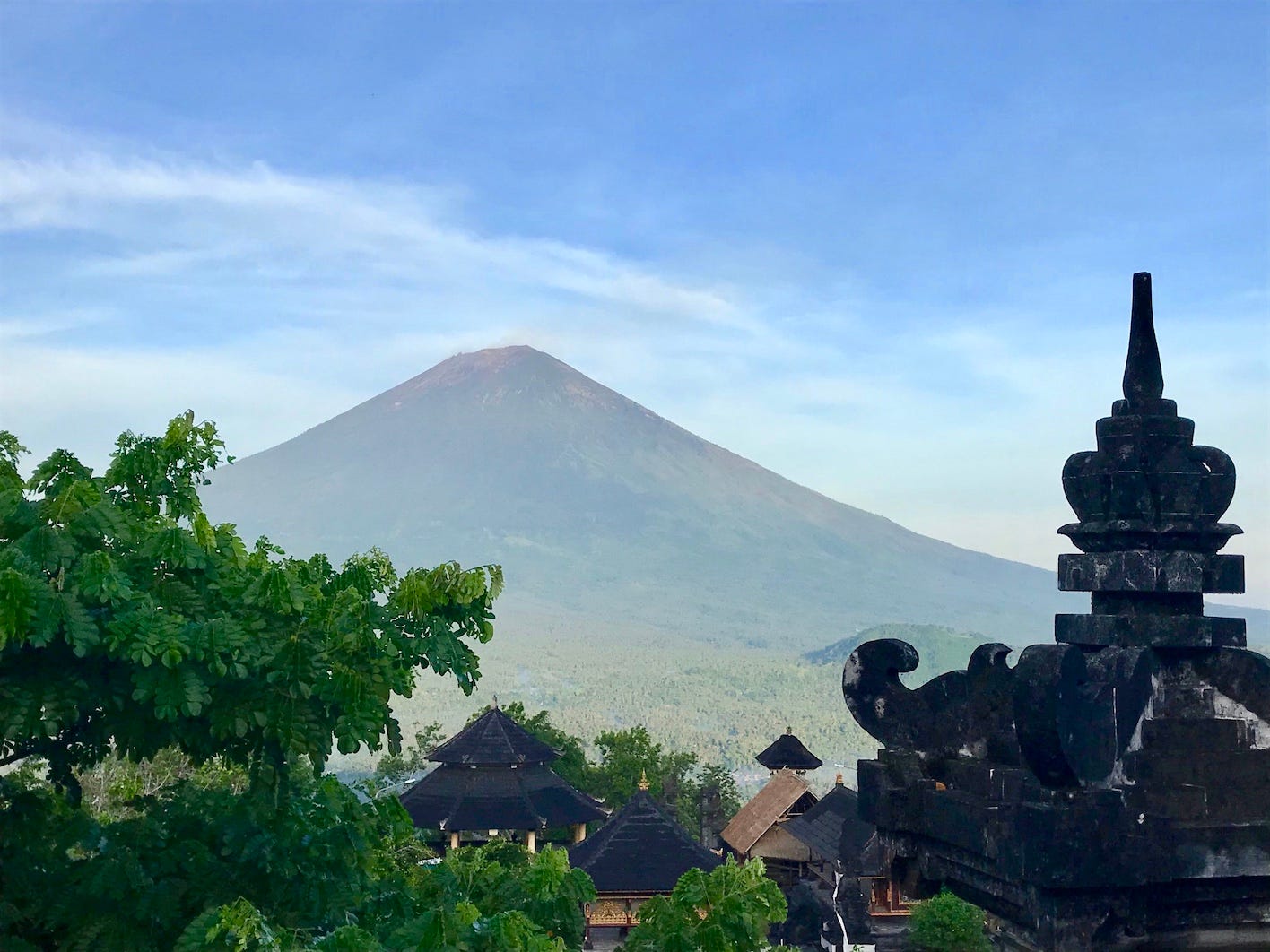Issue #60 - The Challenges of Reopening Bali for Inbound Travel
"There will be a revolution of Bali tourism in terms of source markets and travellers."
Hello. Welcome to issue 60 of Asia Travel Re:Set…
South East Asia’s unfolding reopening plans are - Singapore’s clearly structured roadmap aside - piecemeal and padded with fine print.
Thailand continues to confuse, although it appears ready to scale up inbound access.
Elsewhere, Indonesia, Vietnam and Malaysia are “trial opening” resort destinations all at the same time with unclear formulas for creating sustainable demand.
Quarantines, no matter how much they are shortened or spun, will have a dampening effect on visitor demand - and airlines, it seems, are taking this into account. Malaysia is at least confronting this fact for Langkawi.
As the region approaches its peak season, today’s edition features interview extracts with the Bali Hotels Association about the challenges and outlook for tourism in Bali.
Thanks for being on board,
Gary
The Sunday Itinerary
- This Week’s Top 5
Updates from Australia, Cambodia, Malaysia, Thailand, Vietnam
- The Challenges of Reopening Bali for Inbound Travel
Slow progress for welcoming back international tourists mirrors regional uncertainty
This Week’s Top 5
Updates from Australia, Cambodia, Malaysia, Thailand, Vietnam
Fever pitch in Singapore as Australia’s Prime Minister Scott Morrison says a Phase 1 bilateral travel bubble should be confirmed next week. As elsewhere, check the fine print before booking. Further announcements are expected.
Long-term planning in Cambodia, which unveiled a Siem Reap Tourism Master Plan extending through 2035, and includes building a new airport.
Testing the inbound waters in Malaysia, whose long-trailed reopening of Langkawi begins on 15 November. As elsewhere, check the fine print before booking. Phase 2 of Malaysia’s reopening is slated to commence in February.
High hopes and ongoing scepticism in Thailand as Phase 1 of the government’s November reopening of 17 provinces is extended to visitors from 46 countries. As elsewhere, check the fine print before booking. Phase 2 to follow.
Cautious optimism in Vietnam as 5 regions could welcome arrivals from 72 countries in November. As elsewhere, check the fine print before booking. Phase 2 of the reopening would begin in January. Phase 3 in Q2 2022.
The Challenges of Reopening Bali for Inbound Travel
Bali is preparing to welcome back international tourists for the first time in 19 months. Progress is slow, however, and the situation remains complex.
This week, I chatted with Simona Chimenti, Marketing & Media Relations Director of the Bali Hotels Association and General Manager of The Pavilions Bali in Sanur, and Melina Caruso, Technology & Marketing Consultant of the Bali Hotels Association, for The South East Asia Travel Show’s new Destination 2022 season.
We discussed the challenges and changes up ahead for hotels, airlines and all travel businesses:
Will the list of 19 approved countries be revised?
Will the quarantine period be reduced from its current 5 days, or removed?
How are bookings shaping up for Christmas, New Year & Lunar New Year?
Will visitor profiles and key source markets change?
And what is the current advice for travellers planning a trip to Bali?
Selected highlights from the interview are reprinted below.
CLICK HERE (website), HERE (Apple Podcasts) or HERE (Spotify) to listen to the full interview.
“There will be a bit of a revolution of Bali tourism in terms of source markets and the types of travellers.”
ATR: Bali officially reopened to international travellers from 19 countries on 14 October, but no inbound flight slots were filled. It seems rather confusing – what is the current situation regarding inbound travel?
BHA: It does look a little bit confusing, but the way we have to look at it is that this is a slow process but a necessary first step towards reopening to international travellers. There are a lot of rules and regulations that are currently being defined, and the situation is literally changing by the day.
At present, visitors from 19 countries are allowed to fly directly to Bali, but it will take a bit of time for international airlines to adjust their schedules and occupy the slots.
ATR: What are the particular challenges that Bali faces right now in reopening to international travel?
BHA: Some of the regulations are an obstacle, but there does need to be a way to measure vaccinated travellers and countries from which visitors are allowed to travel here.
A big concern is that the approved countries are based on the COVID-19 case-per-100,000 list produced by the WHO. Travellers might be concerned that things could change after they’ve booked, as happened when the UK reopened to travel, for example. Airlines are obviously a bit nervous about what this would mean from a commercial point of view.
“Hopefully, the pilot opening will help to clarify and ease some of the regulations, because simplicity is what we need.”
Hopefully, the pilot opening we are going through in October and November will help to clarify and ease some of the regulations, because simplicity is what we need.
As we have seen in many places, the first step of reopening is not the final step. Things do - and will - evolve.
ATR: Bali reduced its quarantine from 8 days to 5, but won’t that still be a barrier to travel?
BHA: For sure. When we put ourselves in the shoes of someone wanting to come on holiday, having to spend 5 days either in a hotel room or moving around only a resort is a limitation that most travellers would rather avoid.
In the bigger picture, it is a gradual process, and we are looking for a complete relaxation of the quarantine. We are in a destination where 70% of the local population is vaccinated, and everyone visiting will also need to be vaccinated.
“For many regional Asian markets, the 5-day quarantine won’t fit their average length of stay - which tends to be quite short.”
Pent-up demand is there for Bali and there is a huge amount of interest in the destination, but there is also the attitude from a large amount of travellers that they are sitting and waiting to see what happens. People are comparing internationally, and if another destination is making it simpler then they have a choice to make.
For many regional Asian markets, the 5-day quarantine won’t fit their average length of stay - which tends to be quite short - and regular travel pattern. On top of this, there may be restrictions in terms of the quarantine they would need to undergo when they return to their home country after visiting Bali.
ATR: Bali should be heading into its peak season. What is the outlook for this year?
BHA: Usually, Christmas and New Year is a very busy time for travel to Bali from a lot of nationalities. Visitors come from Europe, US, Canada plus the near-Asia market. It’s also a time when the domestic Indonesian market tends to travel, so its quite a short but very intense period.
This year, it’s very much on hold until we know what is going to happen regarding entry requirements and quarantine and visa regulations.
ATR: Currently visitors are permitted to enter from 19 countries. Is that list likely to change?
BHA: Definitely, it is going to change, because it is based on the WHO matrix and situations can change quite quickly during the pandemic. Some countries may also get dropped if they do not have reciprocal entry arrangements with Indonesia.
We would also expect more countries to be added in the medium term, just as we have seen when other destinations have opened up.
ATR: Australia is a priority inbound market, but it isn’t included on the list - could that change?
BHA: Australia is very important to Bali, but the government has been pretty clear throughout the pandemic that they are very conservative about their estimations for international travel. Based on what was on the flight schedules for Qantas, I think April is the earliest they are thinking for Bali so I guess that was taken on board when Indonesia compiled its list of 19 eligible countries to visit Bali.
ATR: Looking ahead to 2022 in the hope that travel will normalise to some degree – although it’s not yet going to return to the ‘buy-and-fly’ culture we enjoyed before – what are the realistic expectations for Bali? Will it bounce back by this time next year?
BHA: We very much hope so. I think we have to be realistic, it’s not going to go straight from 0 to 100. It will be a learning curve along the way. The profile of travellers may be different in the first few months, and there may be different demographics travelling. So there will be a bit of a revolution of Bali tourism in terms of source markets and the types of travellers.
“The profile of travellers may be different in the first few months.”
Hopefully, in a year’s time we should be back to a point where we have a steady inflow on international and domestic visitors.
There is a definite love affair with Bali, especially among people who have visited before, and I think our repeat business will bounce back a lot quicker than for first-time visitors. And Bali is an amazing destination - the people are resilient, the tourism industry is very strong and we have all learnt a great deal during this time.
And, that’s a wrap for Issue 60.
Next week, Dr Jaeyeon Choe will be back for Issue 8 of the monthly Asia Pacific Travel & Tourism Report.
Until next Sunday, find me on Twitter, LinkedIn and the Asia Travel Re:Set website.
Have a great week,
Gary






